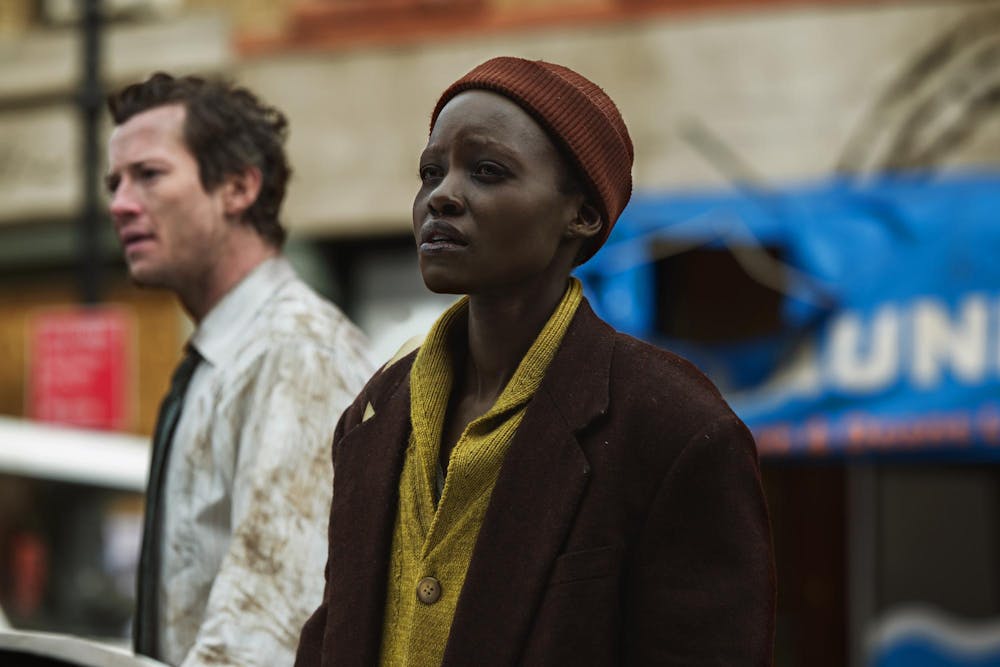After finishing “A Quiet Place: Day One,” I realized there were several specific pros and cons that balance each other out. This ultimately led to a lot of introspection, and prompted me to think about how I should interpret the film.
The premise is simple: it presents the global state of emergency caused by the invasion of sound-sensitive extraterrestrials, through the eyes of Sam (Lupita Nyong’o,) a terminally ill woman living at a hospice facility outside New York City. Initially, Sam is portrayed to be a pessimist — she finds her life to be meaningless, seeing that she does not have much longer to live.
When nurse Reuben (Alex Wolff) persuades Sam to accompany other residents of the hospice facility on a trip to the city to see a marionette show, Sam is justifiably reluctant but tags along anyways. In the middle of the show, a plethora of meteor-like objects streak across the sky, crashing onto Earth and marking the beginning of the aliens’ rampage.
Such a slice-of-life introduction to a grand franchise betrays most expectations I had going in. Aside from the thunderous arrival of the extraterrestrials and the catastrophic chaos that ensues, the film fails to answer any questions about what the aliens are, where they came from, and why they came at all. The only information available to the viewers is that they kill anything that makes sound, which isn’t much to go on.
Clocking in at an hour and 39 minutes, “Day One” is only slightly longer than the other two installments, and it personally felt like an ambivalent watch to me.
To begin, the film is largely eventless — it literally follows Sam and her cat, Frodo, in a day-in-the-life type scenario trying to make sense of the world of chaos surrounding them. Speaking of the cat, Frodo has the thickest plot armor I’ve ever witnessed in a horror movie. Come hell or high water, this cat manages to evade danger at every point. Over the entire runtime of the film, Frodo survives a devastating stampede, numerous alien attacks and drowning, and the cat even escapes from the extraterrestrials while trapped at a burning construction site.
On the flipside, being eventless let this movie paint a viscerally rich portrait of how deep helplessness can permeate the human psyche. “Day One” is notably an emotionally raw film. When Sam accepts the world has fallen into ruin and society is on the brink of collapse, she packs her bags and embarks on a trip to Harlem, to visit a pizza place where she shared fond memories with her late father.
Upon encountering Eric (Joseph Quinn,) the two continue their journey together in silence. Although there isn’t much dialogue between the two except at key moments, both Nyong’o and Quinn play their roles phenomenally in terms of expression and body language. In a scene wherein the pair are at Sam’s apartment to find pain medication, a heavy thunderstorm masks all sound, leading both to release guttural screams of frustration and vulnerability. The moment symbolizes their acknowledgement of powerlessness in the face of unfathomable adversity, but pushes them to keep going.
My favorite part of the film is when the duo finally reaches Harlem. Sam visits the club where she used to watch her father play jazz as a child, and Eric performs a magic trick in front of an imaginary crowd, before finally bringing Sam the pizza she traveled all the way to Harlem to eat.
This nostalgic whirlwind gives Sam a new lease on life, letting her leave behind the burden of pessimism she used to carry before the invasion. Seeing this level of character development in just a short period of time was something I found impressive, and I commend Nyong’o for her efforts in this role.
This film accurately depicted the emotional and physical struggle that survivors of the invasion in “A Quiet Place” went through in its early days, but ultimately failed to give longtime fans the answers to pressing questions about the storyline. Nevertheless, I enjoyed it and recommend it to anyone already familiar with “A Quiet Place.”






